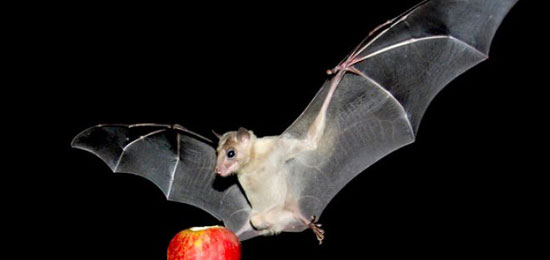
An Egyptian fruit bat in a laboratory experiment. Research indicates that the bats adjust their sonar system to distinguish food from obstacles. Nachum Ulanovsky
Fruit bats make a clicking sound with their tongues to help themnavigate their way to the fruits they feed on. The clicking produces afan–shaped sonar beam that bounces off an object and returns an echo tothe bat.
Now scientists are reporting that the bats have more control over these echolocation abilities than previously thought.
Researchers from Israel and the United States found that the bats canwiden or shrink the sonar beam they send out, and adjust the distancethe beam travels by changing the loudness of their clicks.
That means the bats “can fly around in a really cluttered field” andstill efficiently find fruit, said an author of the new study, CynthiaMoss, a cognitive scientist at the University of Maryland.
The study appears in a recent issue of the journal PLoS Biology.
Dr. Moss and her colleagues trained five Egyptian fruit bats to findand land on a plastic sphere that was moved to different places in adark room. When the researchers filled the room with obstacles, the batswere able to cover three times as much area with each pair of theirclicks as they did when there were no obstacles.
They did this by increasing the volume of the clicks, which areemitted in pairs, and by adjusting the width of their sonar beam. Thesonar beam is adjusted in the same way humans might change their fieldof vision to zero in on a person in a crowded room.
Although clicking is unique to fruit bats, other bats may have similar control of their sonar beams, Dr. Moss said.
